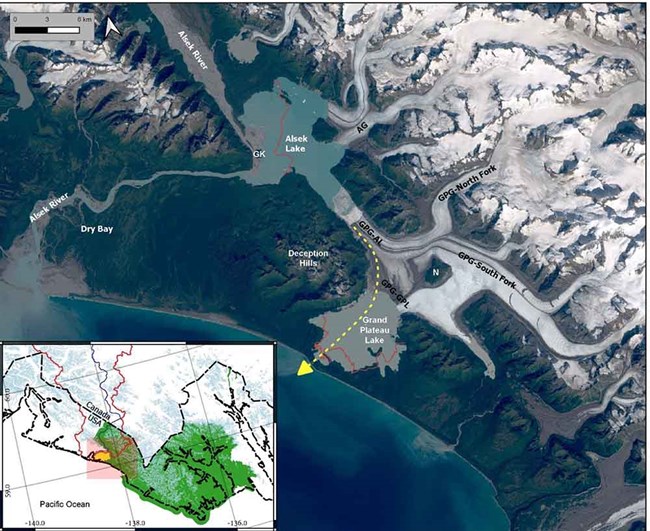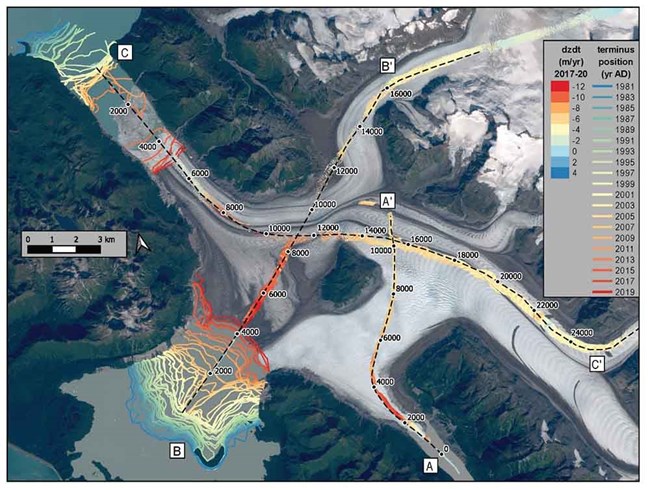Last updated: October 19, 2022
Article
The impacts of glacier retreat and landscape change

Red lines show extent of Alsek and Grand Plateau lobes in 1958; both lake basins were completely occupied by glacier ice in 1928 International Boundary Commission map. Inset shows location of the main map (red rectangle) in southern Alaska and Canada.
Glacier retreat is a well-known cause of global sea level rise, but glacier retreat can also fundamentally alter the landscape. These landscape changes include not only physical and ecological impacts, but sociocultural impacts as well. We anticipate the Alsek River to change course over the next few decades and result in significant socioeconomic impacts and park management challenges.
The Alsek River is a large (250 km-long) glacial river that originates in the icefields of Canada’s Yukon Territory before passing through British Columbia and Alaska. It joins the Pacific Ocean in Dry Bay, just downstream of Alsek Lake (Figure 1). Dry Bay is a broad delta that has a long history of human occupancy and usage associated with fishing, hunting, and as an access corridor inland through the St. Elias Mountains (the river corridor was a “highway” to the interior for indigenous people living around Dry Bay as early as the 15th century). The Alsek River flows through conservation properties on both sides of the international border that comprise the world’s largest contiguous protected area, a UNESCO World Heritage Site, before entering Alsek Lake and finally passing through Dry Bay to the ocean. Alsek Lake is a glacial lake at the terminus of Alsek Glacier and is also fed and impounded by a rapidly thinning tongue of Grand Plateau Glacier.

Dashed black lines show transect locations and longitudinal distances from origin (m) for glacier surface profiles shown in Figure 3. Base is Sentinel-2 image acquired September 10, 2018; Albers equal area projection.
Our glacier monitoring and research shows that continued thinning of the Grand Plateau Glacier will soon connect Alsek Lake and Grand Plateau Lake. Continued shrinkage of Grand Plateau Glacier is virtually certain and thinning in the terminus region that separates Grand Plateau and Alsek Lakes is accelerating. This will allow the existing Grand Plateau Lake outlet to capture some or all of the Alsek’s flow, potentially leading to a permanent separation in which the Alsek River abandons the Dry Bay delta with a cascade of consequences for the long and ongoing history of human use there.
In time, salmon habitat will degrade as the Alsek River becomes a sluggish, vegetation-choked clearwater stream surrounded by high brush and open forest, no longer connected to glacier water flow. Meanwhile, any anadromous fish populations in the upper Alsek drainage will need to navigate the steep Grand Plateau outlet in order to maintain population viability. Numerous other ecosystem-level impacts of the glacier retreat can be predicted, but there will also be consequential socioeconomic and cultural impacts from these changes. Human activities, institutions, and traditions have been built around the river’s current location and are threatened when it moves.
As of 2020, in the Dry Bay area there are nearly 60 companies with commercial use authorizations, 8 airstrips, 3 NPS employee housing buildings, a public use cabin and restroom, 6 other NPS outbuildings, 110 km of maintained off-highway-vehicle accessible trails, a takeout facility for approximately 800 wilderness rafters per year (about half of which are commercially guided), a commercial salmon fishery, a fish cannery, 19 permanent fish camps (small cabins for commercial fishing operators), and 3 commercial hunting/fishing lodges.
As the Alsek outlet shifts from Dry Bay to Grand Plateau, it shifts from Glacier Bay National Preserve into Glacier Bay National Park. Dry Bay was identified as a national preserve to protect traditional subsistence uses as well as commercial fishing, hunting opportunities, and recreational uses—uses that are not allowed in Glacier Bay National Park. This legislatively mandated distinction in land status presents a considerable obstacle to any effort to adapt existing human uses to this climatically driven, landscape-scale change.
News Release, April 6, 2021
Alsek River Mouth Predicted to Shift 20 Miles South of Current Location
Quo vadis, Alsek? Climate-driven glacier retreat may change the course of a major river outlet in southern Alaska
Abstract
Climate change-induced glacier retreat can have substantial localized impacts that often go unnoticed in the sparsely populated regions where they occur. Here we predict that retreat of Grand Plateau Glacier, in southern Alaska, USA, will reroute the outlet of a major river with consequences for human activity in this remote region. The glacier terminus separates Alsek Lake and the present Alsek River outlet from Grand Plateau Lake. In response to thinning and retreat of that terminus, both lakes have more than doubled in size since 1958. Laser altimetry shows that terminus thinning continued at rates of up to 10 m/yr from 2017 to 2020. Radar soundings show that the bed of the thinning glacier terminus extends to >400 m below sea level, and that the two lakes will become conjoined within at most a few decades as the terminus further retreats. We predict that Alsek River will then abandon its present Dry Bay outlet channel in favor of the much steeper outlet of Grand Plateau Lake, 28 km to the southeast. Anadromous fish and associated predators in the lower Alsek will need to adapt to this change. Traditional and modern human activities centered on Dry Bay include commercial fishing, subsistence and sport hunting and fishing, and the finishing point for a world-renowned wilderness rafting expedition. Under present management guidelines, those activities cannot be relocated to the predicted future outlet, which sits within the federally designated wilderness of Glacier Bay National Park.
Loso, M. G., C. F. Larsen, B. S. Tober, M. Christoffersen, M. Fahnestock, J. W. Holt, and M. Truffer. 2021. Quo vadis, Alsek? Climate-driven glacier retreat may change the course of a major river outlet in southern Alaska. Geomorphology 384: 107701.
